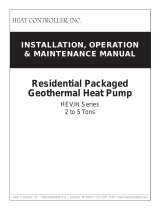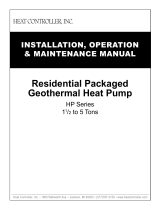
Page 13
CLIMATE MASTER, INC.
LIMITED EXPRESS WARRANTY/ LIMITATION OF REMEDIES AND LIABILITY
It is expressly understood that unless a statement is specifically identified as a warranty, statements made by Climate Master, Inc., a Delaware corporation, (“CM”) or its representatives, relating to CM’s products, whether oral,
written or contained in any sales literature, catalog or agreement, are not express warranties and do not form a part of the ba
sis of the bar
gain, but are merely CM’s opinion or commendation of CM’s products. EXCEPT AS
SPECIFICALLY SET FORTH HEREIN, THERE IS NO EXPRESS WARRANTY AS TO ANY OF CM’S PRODUCTS. CM MAKES NO WARRANTY AGAINST LATENT DEFECTS. CM MAKES NO WARRANTY
OF MERCHANTABILITY OF THE GOODS OR OF THE FITNESS OF THE GOODS FOR ANY PARTICULAR PURPOSE.
GRANT
OF
LIMITED EXPRESS
W
ARRANTY
CM warrants CM products purchased and retained in the United States of America and Canada to be free from defects in material and workmanship under normal use and maintenance as follows: (1) All complete air conditioning,
heating and/or heat pump units built or sold by CM for twelve (12) months from date of unit start-up or eighteen (18) months fr
om date of shipment (from factory), whichever comes first; (2) Repair and replacement parts, which are
not supplied under warranty, for ninety (90) days from date of shipment (from factory). All parts must be returned to CM’s factory in Oklahoma City, Oklahoma, freight prepaid, no later than sixty (60) days after the date of the failure
of the part; if CM determines the part to be defective and within CM’s Limited Express Warranty, CM shall, when such part has been either replaced or repaired, return such to a factory recognized dealer, contractor or service
organization, F.O.B. CM’s factory, Oklahoma City, Oklahoma, freight prepaid. The warranty on any part repaired or replaced under warranty expires at the end of the original warranty period.
This warranty does not cover and does not apply to: (1) Air filters, fuses, refrigerant, fluids, oil; (2) Products relocated after initial installation; (3) Any portion or component of any system that is not supplied by CM, regardless of
the cause of the failure of such portion or component; (4) Products on which the unit identification tags or labels have been r
emoved or defaced; (5) Products on which payment to CM is or has been in default; (6) Products which
have defects or damage which result from improper installation, wiring, electrical imbalance characteristics or maintenance; or
are caused by accident, misuse or abuse, fire, flood, alteration or mis-application of the product; (7)
Products which have defects or damage which result from a contaminated or corrosive air or liquid supply, operation at abnormal temperatures, or unauthorized opening of refrigerant circuit; (8) Products subjected to corrosion or
abrasion; (9) Products manufactured or supplied by others; (10) Products which have been subjected to misuse, negligence or acc
idents; (1
1) Products which have been operated in a manner contrary to CM’s printed instructions; or,
(12) Products which have defects, damage or insufficient performance as a result of insufficient or incorrect system design or the improper application of CM’s products.
CM is not responsible for: (1) The costs of any fluids, refrigerant or other system components, or associated labor to repair or replace the same, which is in
curred as a result of a defective part covered by CM’
s Limited Express
Warranty; (2) The costs of labor, refrigerant, materials or service incurred in removal of the defective part, or in obtaining and replacing the new or repaire
d part (except for the limited labor coverage set forth above); or
, (3)
Transportation costs of the defective part from the installation site to ClimateMaster or of the return of any part not covered
by CM’
s Limited Express Warranty.
Limitation: This Limited Express Warranty is given in lieu of all other warranties. If, notwithstanding the disclaimers contained herein, it is determined that
other warranties exist, any such express warranty
, including without
limitation any express warranties or any implied warranties of fitness for particular purpose and merchantability shall be limi
ted to the duration of the Limited Express
Warranty.
LIMITA
TION OF
REMEDIES
In the event of a breach of the Limited Express
W
arranty
, CM will only be obligated at CM’
s option to repair the failed part or unit or to furnish a new or rebuilt part or unit in exchange for the part or unit which h
as failed. If
after written notice to CM’
s factory in Oklahoma City
, Oklahoma of each defect, malfunction or other failure and a reasonable number of attempts by CM to correct the defect, malfun
ction or other failure and the remedy fails of
its essential purpose, CM shall refund the purchase price paid to CM in exchange for the return of the sold good(s). Said refun
d shall be the maximum liability of CM.
THIS REMEDY IS THE SOLE AND EXCLUSIVE
REMEDY OF THE BUYER AGAINST CM FOR THE BREACH OF CONTRACT, FOR THE BREACH OF ANY WARRANTY OR FOR CM’S NEGLIGENCE OR IN STRICT LIABILITY.
LIMITA
TION OF
LIABILITY
CM shall have no liability for any damages if manufacture’s performance is delayed for any reason or is prevented to any extent by any event such as, but not limited to any war, civil unrest, government restrictions or restraints,
strikes or work stoppages, fire, flood, accident, shortage of transportation, fuel, material, or labor, acts of God or any other reason beyond the sole control of CM. CM EXPRESSLY DISCLAIMS AND EXCLUDES ANY
LIABILITY FOR CONSEQUENTIAL OR INCIDENTAL DAMAGE IN CONTRACT, FOR BREACH OF ANY EXPRESS OR IMPLIED WARRANTY, OR IN TORT, WHETHER FOR NEGLIGENCE OR AS
STRICT LIABILITY.
OBTAINING
W
ARRANTY PERFORMANCE
Normally, the contractor or service organization who installed the products will provide warranty performance for the owner. Should the installer be unavailable, contact any CM recognized dealer, contractor or service
organization. If assistance is required in obtaining warranty performance, write or call:
Climate Master, Inc. • Customer Service • 7300 S.W. 44th Street • Oklahoma City, Oklahoma 73179 (405) 745-6000
NOTE: Some states or Canadian provinces do not allow limitations on how long an implied warranty lasts, or the limitation or ex
clusions of consequential or incidental damages, so the foregoing exclusions and limitations may not
apply to you. This warranty gives you specific legal rights, and you may also have other rights which vary from state to state
and from Canadian province to Canadian province.
Please refer to the CM Installation, Operation and Maintenance Manual for operating and maintenance instructions.
*LC083*
Rev.: 10/00 LC083


















